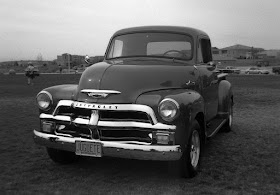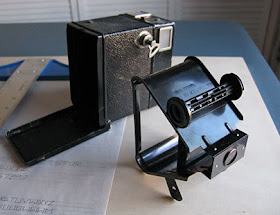When cameras got small enough to carry around about a century ago, manufacturers started fitting them with reflective, waist-level viewfinders. The simplest type had a lens and a mirror which projected an image onto a small ground-glass screen. That produced a rather dim look at the scene being photographed and was subject to interfering glare. On better quality cameras, the ground-glass was replaced with a bi-convex lens which yielded a magnified and very bright view of the subject. The nicest example of a brilliant finder I have is on one of my oldest cameras, a
1A Folding Pocket Kodak Special.
The nickel silver hood on the 1A finder protects the viewing lens surface in the closed position. When flipped up from the back, the viewing lens is revealed and the hood helps to shield the lens surface from glare and reflections. Lifting the hood from the front allows access for cleaning the inner lens and mirror surfaces. The viewfinder can also be swiveled 90 degrees to allow for either vertical or horizontal compositions. Corner cut-outs help frame the view as appropriate for the camera's orientation.

While the brilliant waist-level finder provided a helpful preview of the image on film, the reversed mirror image was problematic for following action. As film speed got faster and photographers sought more candid action shots, camera makers responded by producing medium-format instruments with both waist-level and eye-level finders. Eventually, the waist-level finders disappeared, and with increased miniaturization, the eye-level finders -- particularly in 35mm cameras -- shrank down to minuscule proportions during the 1930s and '40s.
At around the mid-century mark there was a rebound in demand for brighter viewfinders, and one began to see bright eye-level finders with luminescent frame lines in 35mm cameras. Medium-format manufacturers added fresnel screens to improve the brightness of their reflex finders on high end slr and tlr cameras.
Meanwhile, the really dramatic development in viewfinder design was taking place at the mass market end of the spectrum as Kodak, Ansco and other makers introduced fixed-focus, plastic bodied roll film cameras sporting a picture window on the world. Under the hood of the Fifties era box camera was a massive viewing lens that was four or five times larger than those in the brilliant finders found in the old box and folding cameras. With the increasing availability of cheap, fast color processing and printing, people actually were getting a preview of what their pictures were going to look like before they snapped the shutter.

The convenience of the 35mm cassette ultimately overtook the advantages enjoyed by the cheap medium format roll film cameras, along with rapid advances in electronic automation of exposure and focus functions. Of course, digital then came along and demolished the popular demand for any kind of analog photo technology. Oddly enough, in the midst of the digital revolution, the brilliant viewfinder box cameras made a comeback when it was discovered that you could point your digital at the old box camera's viewfinder and get an interesting result that incorporated rounded frame corners, lens aberrations, and possibly some fungal smudges to produce images of imagined artfulness.

For a time, there was quite a spike in the prices on ebay for box cameras with brilliant finders. Luckily for those of us who are still interested in using the cameras with film, most of those through-the-viewfinder (ttv) artists have now moved on to creating digital images of a fantasized past with the iPhone's Hipstamatic app. So, the chances are still pretty good that ten dollars plus postage will get you a great old camera with a brilliant viewfinder.
I have added a link in my web site page about the Argoflex to
instructions on how to restore the viewfinder to its original brilliance.

















































